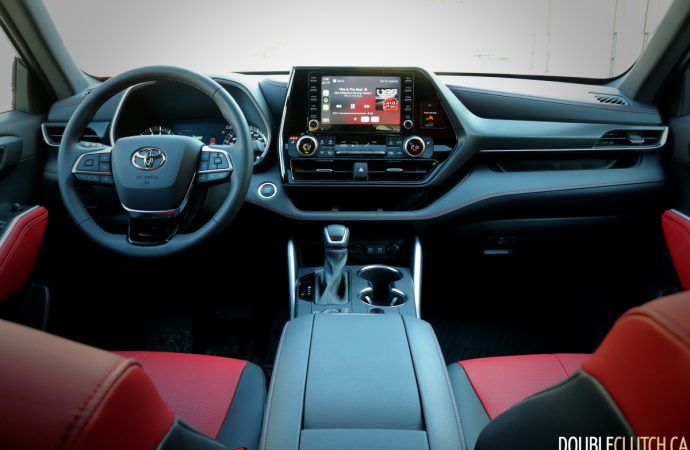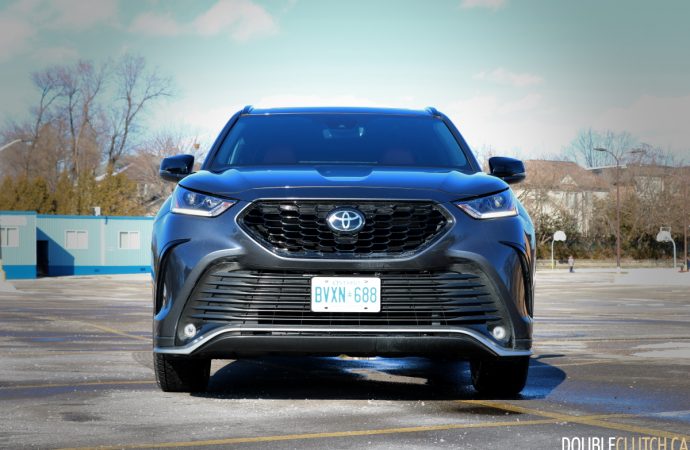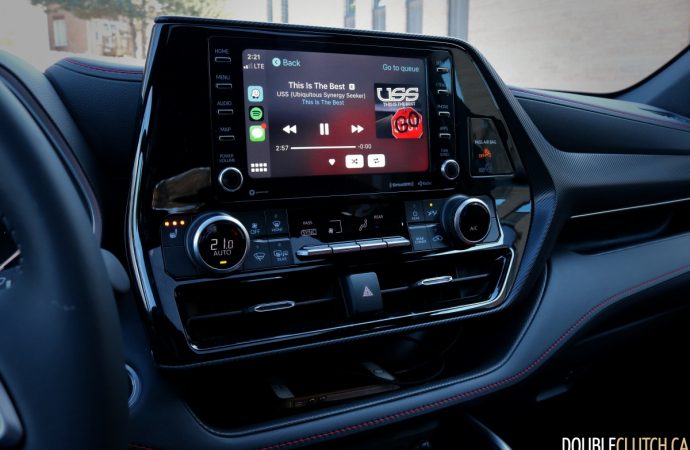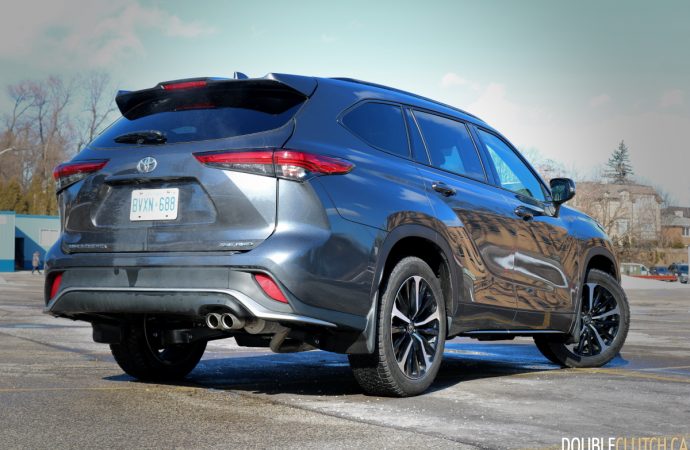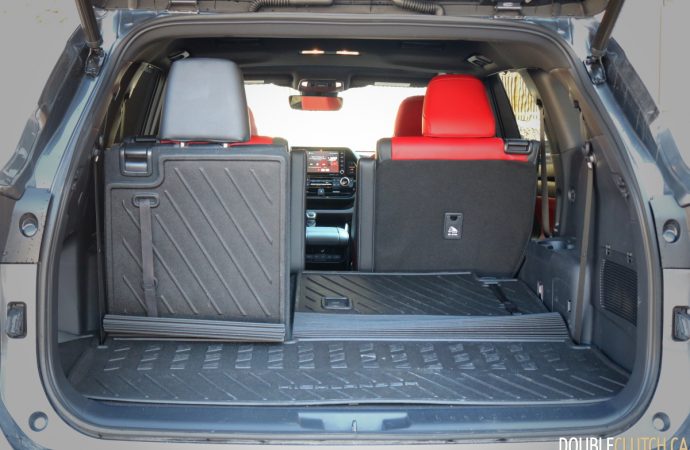First came the Sienna SE in 2011, arguably the first minivan in North America with a sporty trim. Next up was the RAV4 SE which added genuine motorsports pedigree by winning the American Rally Association’s open 2WD class with only safety gear, a welded differential and a transmission cooler to differentiate it. Now the 2021 Toyota Highlander XSE is here to turn up the visual heat in the three-row crossover segment.
Between the gaping lower grille, pinched upper grille and exaggerated scoops, it certainly looks different. Likely less controversial is the XSE’s smoked lamp treatment, a subtle tweak that adds a stealthy dose of aggression. Moving along to the side of the Highlander XSE, this family hauler rolls on dubs that feature the two-tone black and diamond-cut finish that’s so en vogue these days. Because they’re largely blacked-out, they do look rather small for 20-inch wheels.
The biggest addition that the XSE trim makes to the Highlander’s interior is the availability of red upholstery. From a Lamborghini Huracan Evo to a 1988 Pontiac Sunbird, red interiors make everything better. And while Toyota’s Softex vegan upholstery isn’t leather, it sure is both very soft and a reasonable facsimile of leather. In fact the only caveat of the Highlander XSE’s Cockpit Red interior is that it isn’t available with Ruby Flare Pearl paint, something that may displease the handful of buyers desiring a truly wonderfully obnoxious spec.
In addition to the usual door and console cubbies commonplace in crossovers, the Highlander has two rubber-lined shelves on the dashboard that can fit whatever the driver and front passenger want, from three eights of a pool noodle to 27 months of leftover Taco Bell hot sauce packets to a solid handful of highly collectable Webkinz to at least several dozen falafel.
Moving on back, the second row in the Highlander XSE features its own climate zone, two USB charging points and captain’s chairs. While the second row offers comfy seats and plenty of room, the same can’t quite be said for the third row. It’s a bit cramped in the way back and the rear bench is rather flat and thinly-padded compared to the other two rows. It’s likely fine for children and short journeys, but adults won’t be comfortable back there for longer journeys. Interestingly enough, when the Cockpit Red interior is optioned, the Highlander’s third row still features plain black upholstery. It’s a material choice perhaps exclusively designed for in-laws.
In terms of in-cabin tech, there’s plenty on offer. The infotainment is an eight-inch touchscreen affair that’s reasonably crisp, if a bit cluttered. There are plenty of hard keys for shortcuts though, which helps simplify Toyota’s visually-busy display. The Highlander XSE gains a seven-inch screen in the gauge cluster which can display everything from the current song playing to fuel economy stats to driver assist status. Plenty of information on tap, but it’s difficult to read in direct sunlight as it’s easily washed-out.
The stereo is a fairly unremarkable six-speaker unit with a noticeably V-shaped sound profile that feels rather quiet. Buyers who really like hearing music in their Highlander will likely want to step up to the Limited trim level which offers an 11-speaker, 1,200-watt JBL system that’s very good indeed.
Moving onto other gadgets, tri-zone climate control and heated front seats aim to keep occupants comfortable even through cold Canadian winters and a windshield wiper de-icer aims to aid visibility in frozen weather. That being said, there is one very desirable comfort feature missing from the Highlander XSE.
See, Toyota is somewhat notorious for offering truly bizarre options mixes on many of their vehicles, and the Highlander is no exception. While the XSE sits in the mid-tier hierarchy of Highlander trim levels, it lacks a common luxury that makes a difference in Canadian winters – a heated steering wheel. I know, point and laugh at the pampered writer who’s grown used to press cars having heated steering wheels, but the fact is that many competitors offer heated steering wheels for thousands of dollars less.
Also unusual is that the Highlander XSE offers sport suspension but not the sportiest all-wheel-drive system available on a Highlander. Limited and Platinum trims get Dynamic Torque-Vectoring all-wheel-drive which might possibly, maybe, perhaps offer more, dynamism than the standard-spec all-wheel-drive system fitted to the XSE.
Powering the 2021 Toyota Highlander XSE is Toyota’s venerable 2GR V6. In this application it cranks out 295 horsepower and 263 lb.-ft. of torque, neither of which are small numbers. Hitched to a slick eight-speed automatic gearbox, it moves the Highlander with proper authority. Sometimes too much authority. If you like torque steer, put your hands up because the Highlander writhes about like an old supercharged Pontiac when accelerating through a lane-change. Hey, if that’s the price to pay for absolutely effortless merging and overtaking, it’s no hardship at all.
What may be a bit of hardship is fuel consumption. Despite high-tech D-4S fuel injection, which uses both port and direct injection for superior power and fuel economy while minimizing carbon buildup, and the ability to dial up more efficient Atkinson-cycle combustion on demand, this is still a reasonably powerful, very big three-row crossover. While the government rating for combined fuel economy is 10.3L/100km, we averaged 12.7L/100km over a week of driving in cold February weather.
One of the big draws of the 2021 Toyota Highlander XSE is its comprehensive suite of active driver assists. Automatic emergency braking with pedestrian detection, adaptive cruise control, lane-keeping assistance, automatic high-beams and blind spot monitoring are all standard and work to mixed effect. The automatic emergency braking can apparently steer around potential collisions and has an adjustable threshold that’s nowhere near excessively intrusive on its medium sensitivity setting. The automatic high-beams also work quite well to illuminate dimly-lit streets.
The adaptive cruise control is adequate although not as aggressive as it could be, often slowing down prematurely and leaving an excessive gap between the Highlander and the car in front. Lane-keep assist functions more like lunch-loss assist, inasmuch as that the system’s tendency to ping-pong between freeway lane markings can really bring out the queasiness in passengers.
In conclusion, the 2021 Toyota Highlander XSE is one of the best three-row crossovers on sale, even though it’s not the absolute best at any one thing. The Kia Telluride and Hyundai Palisade offer more kit and crush the V6 Highlander in fuel economy, and the Volkswagen Atlas is bigger and more spacious. The truth is, not only is the Highlander an excellent all-rounder, there are no bad options among it and the previously-mentioned three-row crossovers. For some, the Highlander’s bold styling and legendary Toyota reputation will make it the crossover to have.


